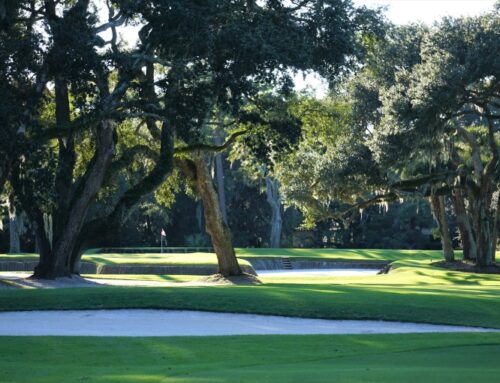High Pointe
MI, USA
Few courses deserve to be included on this site more than High Pointe. Why? Because it embodies many of the best features reflected in the resurgence of today’s golf course designs. Tom Doak, the architect in question and his aptly named Renaissance Design Firm, follows these basic tenants:
- Let the land dictate the course
- Create unique holes with minimal amount of earth moved
- Provide wider than normal fairways to re-introduce strategy
- Place the greens in natural sites and insure they possess great variety
Few courses are blessed with the kind of land Doak had to create the back nine. To his credit, he made the most of it. However, perhaps even more to his credit is the life he enthused into the front nine.
The outward nine is originally set mostly through a former orchard. The land is less compelling so Doak went to work where it matters the most: the greens. The second, sixth, and eighth greens are all heavily contoured, which is as it should be given those holes fall over only moderately interesting land.
Nonetheless, it is the first six holes on the back that truly inspire, similar to the effect the first six holes at Spyglass Hill hold. As usual, regardless of the architectural style, the most compelling holes are found over the most compelling land. Starting with the 10th hole, the land goes up into the beautiful northern Michigan wilderness. Significantly though, given the land was left undisturbed, these holes tend to be both unique and original. The authors have not seen holes remotely like 10th, 12th, 13th, and 14th anywhere in the world. It is this stretch which summons the golfer back time and time again.
Holes to Note:
Forth hole, 195 yards; Doak’s rendition of a Redan. A very good hole but Doak admits it would have been better to provide more of a level fairway to allow the player to bounce his ball onto the green, thus letting it take full advantage of the right-to-left slope of the green.
Eighth hole, 450 yards; Far from the best hole on the course, but most worthy of study. From tee to green, the 8th is Christopher Columbus flat. However, it is made special by the green which has a three foot (!) tier toward the back. From a bland hole, Doak has created a very memorable one. If the hole is forward, the bank in the green can be used as a back stop. If the hole is up top, the golfer in the fairway must figure out a way to chase the ball up onto the back level. If the approach shot doesn’t come off, the golfer is faced with numerous options of how best that day to get near the hole. Honestly, why aren’t there more flat holes with superb greens?
Eleventh hole, 165 yards; A clever par three that is none too long but that can wreck a scorecard. The green is set on a natural ridge that makes it a hit or miss proposition. A wide range of scores is possible. A well struck seven iron leaves a manageable birdie putt. However, a shot tugged a little left will hit the bank on the left of the green and go cascading into the Michigan wilderness. Good luck from down there. Another feature worth noting is this seemingly innocuous hole follows the course’s most overtly dramatic and demanding hole. The 10th is a bruising four par up the hill to a big, but blind, green. As the golfer lurches to the 11th tee the worse for wear, his first view may lull him into a state of complacency. Be warned.
Twelfth hole, 410 yards; The rugged edges of the bunkers are in keeping with its setting and help to highlight the beauty of the hole. The right side of the fairway is the preferred spot but that is where Doak placed two key bunkers well down the right side. A beautiful tree guards the front left of the green. The left side of the green is distinctly higher than the right side and it takes quite a bit of skill to get at the top left hole positions. Conversely, the spine that divides the green can be used to help feed the ball toward the lower right hole positions.
Thirteenth hole, 430 yards; The single best green built in America in the past sixty years. A tremendous amount of thought and work went into the design of this green. The creative player can use the bold contours to help with the recovery shots around the green. Sometimes, the best way to get the ball close to the hole is to play almost 90 degrees away from the hole. If the green is firm, the back bunker is in play. Like a lot of Doak’s greens, it warrants being played on numerous occasions to gain a full appreciation of the options available to the golfer.
Fourteenth hole, 395 yards; Far from a classic, this long four par hole is nonetheless an intriguing proposition. The fairway is humungously wide though it plays smaller as it is humpbacked and throws balls to the side. From there, the long approach shot is to an unreasonably narrow green. However, the surrounds dictated the green size. Not unlike the thirteenth at Prestwick, nobody ever said you had to hit the green. A chip and a putt will need to suffice here four out of five times.
Doak’s ensuing work holds true to the principles of minimalism. He doesn’t just preach it; he is the genuine practitioner whose real quest is to be blessed with excellent property. Doak and his team will spend heaps of time on site. From there, they will create original holes unique to that property. High Pointe is a perfect example. What more can a club ask?
The End




![The Park, West Palm (Lit 9) [2023]](https://golfclubatlas.com/wp-content/uploads/2024/12/IMG_7092-2-scaled-500x383.jpg)



